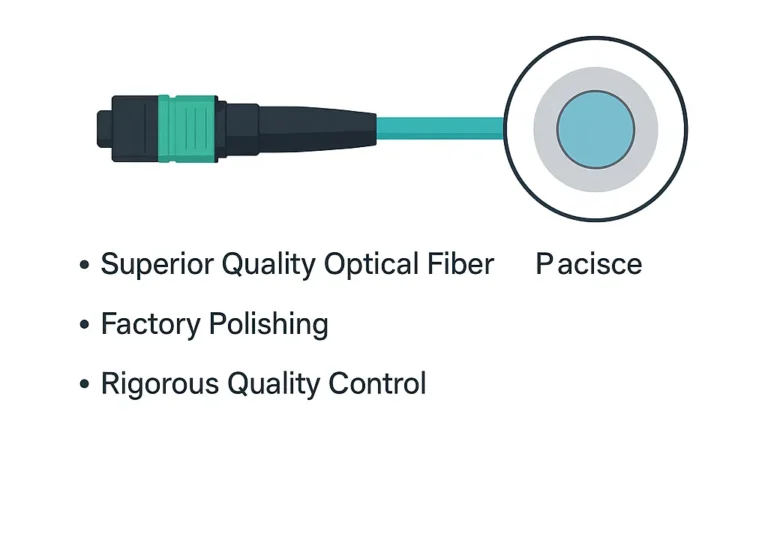How Do Multimode Fiber Optic Cable Prices Compare Across Different Types?

Are you overwhelmed by the varying prices of multimode fiber optic cables? With so many options, pinpointing the right balance between cost and performance can be challenging. But fear not! I’ve examined the key aspects that drive these costs, and I’m here to share how you can match your budget with real-world project needs.
Multimode fiber optic cable prices1 vary based on fiber type (OM12, OM33, OM44), construction (riser, plenum, armored5), and application. Generally, OM1 is the most affordable, while OM4 and specialized cables cost more6. Understanding these differences is crucial for making cost-effective choices.
I’ve managed several data center and FTTA projects where selecting the right cable type often hinged on performance requirements versus budget constraints. I recall a scenario where I needed to decide between OM1 and OM4 for short runs in a campus network upgrade. Although OM4 was tempting for future-proofing, OM1 proved sufficient for the distances involved. That real-life example underlined the importance of precisely matching cable specs to project demands.
What Factors Influence the Cost of Multimode Fiber Optic Cables?
Multimode fiber optic cables7 come in various types and constructions, each influencing the cost. Understanding these factors can simplify your purchasing decision.
The cost of multimode fiber optic cables is influenced by fiber type (OM1, OM2, OM3, OM48), construction (riser, plenum, armored9), and specific applications. OM110 is typically the least expensive, while OM411 and specialized versions are pricier due to enhanced performance features.
When I was a junior engineer, I once mistakenly assumed that OM4 would always be the best choice—until I saw the effect on my project’s budget. I learned the hard way that fiber type directly correlates to cost. It was an eye-opener: price scales with distance requirements and bandwidth considerations.
Fiber Type and Construction
- OM1 Multimode: Known for its affordability, OM1 fibers12 suit short-distance applications. Prices range from $2.50 to $4.00 per foot, depending on ratings like indoor/outdoor plenum or riser-rated cables.
- OM3 Multimode: Designed for higher performance over longer distances, OM3 cables13 cost between $3.28 to $4.50 per foot, with riser and plenum-rated options affecting the price.
- OM4 Multimode: Offering superior performance, OM4 fibers14 cost $4.50 to $5.50 per foot for standard ratings and can reach up to $13.50 per foot for armored or specialized applications.

I remember a project in a commercial building where the client initially wanted OM4 because of its marketing buzz. But after checking the required transmission distance (only 150 meters per link), I realized OM3 was enough. The client saved a significant sum by not overspending on OM4.
Table: Approximate Price Ranges by Fiber Type
| Fiber Type | Typical Price Range (per foot) | Common Use Case |
|---|---|---|
| OM1 | $2.50 - $4.00 | Short distances, legacy networks |
| OM3 | $3.28 - $4.50 | Medium distances, 10G applications |
| OM4 | $4.50 - $13.50 | Longer distances, high data rates |
Specific Examples
For instance, Corning MIC OM1 cables15 are riser rated and tight-buffered, priced from $3.23 to $3.43 per foot depending on quantity. In contrast, Corning MIC OM316 riser-rated cables cost between $3.55 to $3.77 per foot. Meanwhile, Corning MIC OM4 cables17, also riser-rated, range from $4.87 to $5.19 per foot.
I’ve personally used Corning’s MIC cables for a large data center expansion. The pricing was transparent, and the quality was consistent. While budgeting, we broke down costs by floor since each had different trunk cable lengths. This detailed approach helped us stay on track financially.
Pre-Terminated Cables
Pre-terminated cables often come at a premium due to factory termination. For example, a 6.6ft LC-LC 50/125 OM4 duplex multimode PVC cable can cost $28.99 to $34.99. If you prefer plug-and-play convenience, pre-terminated assemblies might save labor costs, though the unit price is higher.
I once recommended pre-terminated cables for a financial firm whose downtime costs were steep. They needed rapid deployment. The cables arrived labeled and tested, significantly reducing installation time. The extra upfront cost of pre-termination was overshadowed by the project’s urgency and potential loss from extended downtime.
Specialized Ratings
Cables with specialized ratings (chemical resistance, armored, or military tactical versions) can be significantly more expensive. An OM4 Multimode with ILA armored construction18 costs around $13.50 per foot, while a military tactical OM4 Multimode is priced at $8.50 per foot. These are often for harsh environments or places with mechanical risks.
Why Is Understanding Cable Construction Important for Cost Efficiency?
Choosing the correct cable construction can lead to significant cost savings without compromising performance.
Understanding cable construction19 (riser, plenum, armored) is vital for cost efficiency, as it helps match the cable's capabilities with its intended environment. This ensures longevity and reliability, avoiding unnecessary expenses on unsuitable types.
During an FTTA project, I saw a company mistakenly install plenum-rated cables in an outdoor conduit. Plenum rating wasn’t necessary, and it inflated costs. Additionally, the cable’s outer jacket wasn’t designed for repeated exposure to moisture. That oversight soon required a full cable replacement.
Riser vs. Plenum vs. Armored Constructions
- Riser Cables20: Suitable for vertical spaces between floors, riser cables are often more affordable than plenum-rated cables.
- Plenum Cables21: Designed for use in plenum spaces where air circulates, these cables are pricier due to their fire-resistant coatings.
- Armored Cables22: Offer additional protection against environmental hazards, thereby justifying their higher costs.
Table: Construction Types and Typical Price Differences
| Construction Type | Purpose/Environment | Price Point | Example Scenario |
|---|---|---|---|
| Riser (OFNR) | Vertical runs, between building floors | More affordable | Office building internal cable shafts |
| Plenum (OFNP) | Spaces circulating air (HVAC) | Moderately higher | Air ducts or areas where fire rating is key |
| Armored | Added protection (rodent, impact) | Highest cost | Outdoor runs, industrial environments |
I’ve found that incorrectly specifying cable construction is a frequent source of budget overruns. Evaluating the environment’s fire rating requirements and mechanical threats upfront saves both time and money.
Conclusion
Navigating the world of multimode fiber optic cables requires understanding the interplay between type, construction, and application. OM1 cables23 provide a budget-friendly solution for shorter distances, while OM4 and specialized cables deliver enhanced performance for more demanding scenarios. Matching cable specifications to your unique conditions is the surest path to optimizing performance and budget.
Remember, the key to making informed decisions lies in comprehensively understanding the factors that affect pricing. That knowledge ensures your telecommunications projects remain cost-effective and future-proof. I learned this firsthand when juggling high-density data center demands alongside rigid budgets—every detail matters.
Footnotes
Provides a comprehensive overview of price differences based on cable types and applications. ↩
Explains what OM1 fiber is and its usual applications, aiding understanding of cost implications. ↩
Details on OM3 fibers to help discern cost-performance ratios. ↩
Offers insights into OM4 fiber's higher costs and enhanced features. ↩
Clarifies different constructions and their impact on prices. ↩
Explanation of various specialized and advanced cables and their pricing influence. ↩
Details various factors affecting fiber cable costs, aiding in budget planning. ↩
Comprehensive comparison of different fiber types to highlight their impact on costs. ↩
Explains how cable construction impacts cost and why it matters. ↩
Detailed look at OM1 fiber to understand when it’s a cost-effective choice. ↩
Information on OM4’s higher performance and cost implications. ↩
Specific cost range and uses for OM1 cables, crucial for budgeting. ↩
Explains cost implications of OM3 fiber's performance features. ↩
How OM4 fiber achieves superior performance, justifying its price. ↩
Price specifics of Corning's OM1 cables offer transparency for procurement. ↩
Specific data on Corning's OM3 cables helps in cost-benefit analysis. ↩
Provides specific cost information for procurement managers considering OM4 cables. ↩
Reflects the higher price for OM4 cables with armored or specialized construction. ↩
Explains why matching cable construction to application can reduce unnecessary expenditure. ↩
Details on riser-rated cables for vertical building runs. ↩
Explains the higher cost of plenum-rated cables due to stricter fire codes. ↩
Discusses the advantages of armored cables and why their protection is worth the price. ↩
Highlights scenarios where OM1 cables are most beneficial, reinforcing cost-efficiency strategies. ↩








